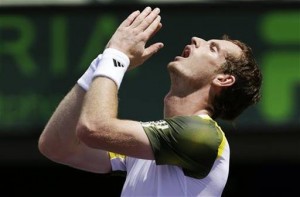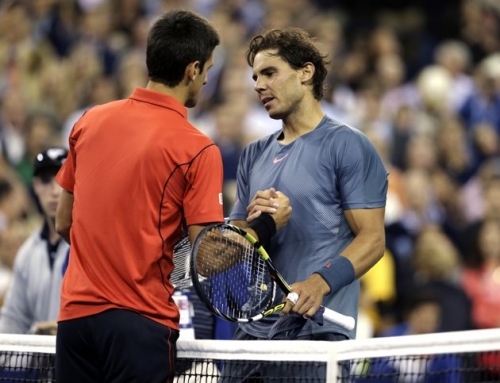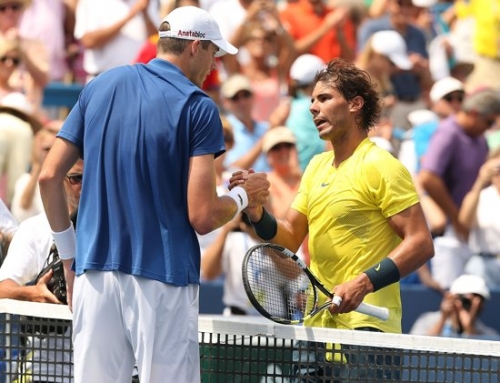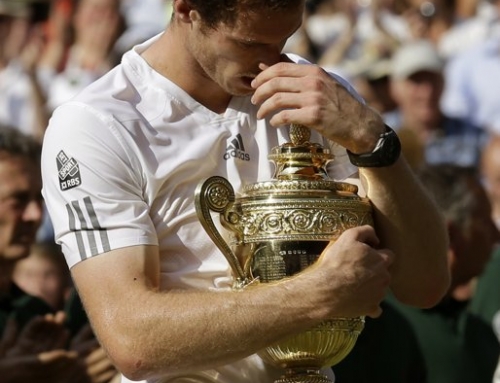 Sometimes, when we see players, we think of their game as fully formed. If you watch years of Jimmy Connors, his game doesn’t seem that much different, though maybe he did things at 39 he didn’t do at 29.
Sometimes, when we see players, we think of their game as fully formed. If you watch years of Jimmy Connors, his game doesn’t seem that much different, though maybe he did things at 39 he didn’t do at 29.
But a player’s game is always a work in progress, from technical changes to strategic changes. Federer’s forehand in 2003 is not the same as he hits it in 2013. Federer can hit his backhand much harder these days, even if he can’t quite hit winners. Nadal added a slice backhand, a bigger serve, and vastly improved volleys.
For years, I’ve watched the Andy Murray game and watched how it changed.
In the early years, Murray was more of a retriever. He didn’t have a huge serve, but he returned well, and his backhand was always a gem. As the years passed, he improved his fitness, he improved the pace of his serve and his forehand.
Now that Murray is under the watchful eye of Ivan Lendl, you can see the aging Czech brain in action. Lendl has had a chance to see the modern game, and he’s crafting his ideas through Andy Murray. Up until Murray joined Lendl, he had been routinely criticized as being too passive. It would be one thing if he were like David Ferrer or perhaps Gilles Simon where hitting hard enough to make winners was outside Murray’s capabilities, but at 6’3″, Murray had plenty of pace. He just reserved it for special moments.
In particular, Murray knew it was hard to beat Nadal by outlasting him. If you want to beat Nadal, you need to outhit him, and that’s tough, but Murray found ways to do that. Only Djokovic found a consistent way to beat Nadal at his own game, willing to hit the 20-30 shots on a regular basis to win matches. The 2012 Australian Open final was the pinnacle of this grueling style of play.
So how has Lendl’s influence changed Murray’s game?
Hit the winner when the opportunity presents itself
Murray generally prefers to stand way back. Like Richard Gasquet, he preferred to stand 6-10 feet behind the baseline and use his running to chase down shots. That’s fine when you’re in your early 20s, but when you get older, the first thing that often goes is your speed. Lendl wanted Murray to use his power more, and to end shots when he had chances to do so, not to stretch out into long points.
Use side to side to make your opponent move
If Murray has a weakness, it’s that he doesn’t like the down-the-line shot much. During some periods of his career, he’s hit the down-the-line well, and those times, he’s been more successful. However, it’s been players like Novak Djokovic, who just loves the down-the-line shot, and hit it on a dime, that has lead Djokovic to number 1.
When Murray first worked on this strategy, he gave sufficient distance from the sideline, often many feet, so he wasn’t that close, so he could learn to hit this strategy.
This strategy was to be a cornerstone in the revised Murray game. This came to a peak in the Miami in something you rarely see: David Ferrer cramping. Ferrer is maybe the fittest player in the game, or he’s up there with players like Murray. It’s hard to get Ferrer tired, but apparently, you can take his legs from him. Few players do this because side-to-side strategy, so popular among beginners, is considered low-percentage tennis at medium and high levels. Lendl has worked to make this a far more reliable way to hit.
Work the topspin
In a way, Lendl’s strengths are Murray’s weaknesses. Lendl played just as well on clay as he did on hard courts. He was actually pretty good on grass, though he never had the huge breakthrough. But all things considered, Lendl’s grass court record still exceeds Murray’s. But it’s his clay prowess that Lendl is superior to his pupil. Lendl his topspin and pace, and yet was patient enough to play long points.
One reason Murray has struggled on clay is that he hits the flattest of the top 4 players. As hard as Federer hits, he his with a fair bit of spin. Of course, Nadal hits with the most spin in the game, but Djokovic is no slouch either.
In the early parts of the semifinal match against Gasquet, Murray worked the shots up high, and Gasquet, who often hits pretty high, was willing to oblige. For a few games, the two played a clay court game on hard courts showing that Murray has been training for the clay. Lendl has observed that Murray needs more topspin, and, at least, on the forehand, Murray is trying to spin more in neutral rally shots.
Love the grind
If Murray has a weakness against players like Djokovic or Ferrer or Nadal, it’s the willingness to grind and the ability to be successful grinding. Djokovic, in his miraculous year in 2011, learned to get to a lot of shots and return it back with interest. To give a sense of this, Dimitry Tursunov, once a top 20 player had the misfortune of playing Berdych twice in 2013 in back to back weeks.
Berdych is a big guy who doesn’t move that fast. He manages to hide this pretty well because he can clock the ball. Whenever he blasted a shot, Tursunov would barely get there and mishit the ball. Djokovic, by contrast, would get to the ball, and still hit a solid shot.
Add that to Djokovic’s ability to get to shot after shot after shot, and you have a wall. When Nadal lost 7 times in a row to Djokovic, he lost because Djokovic was able to do to Nadal what Nadal does to everyone else: get to shots.
While Murray lacks the precision of the Djokovic or Nadal game who seem to be able to hit a dime wherever they aim, Murray can still at least get the ball back in the court. And if he can’t last 20-30 shots, he’ll have to go for big shots, and that adds additional risk.
Murray has been adding the down the line high looper from his forehand. It’s a neutral shot that isn’t meant to win the point, but it changes the direction of the shot without too much risk.
Run around the backhand
Because Andy Murray has always had a pretty good backhand, he’s never had a huge reason to run around his backhand. Even so, two of the best players in the world, Roger Federer and Rafael Nadal, do it all the time. Murray generally does this to get to inside-in or inside-out shots. With Murray’s emphasis on hitting bigger forehands, this side is now enough of a weapon to attack with, so Murray has been, on occasion, running around his backhand.
Work the lob
This is a new twist that Murray unveiled in Miami. Some players are hard to lob. Roger Federer is perhaps the hardest guy to lob. He recognizes a lob faster than nearly everyone. In any case, most pros typically pass on the first shot. Murray still does this, but he looks for certain moments to lob, and he went for the lob at key moments in the match. The lob is something that’s pretty rare these days. It happens, but few players do it really well, and yet it can turn around a point in surprising ways.
Break when you can
Lendl doesn’t like Murray playing extended points unnecessarily. You would often see matches where Djokovic won easily, Nadal won easily, and Murray won like 7-5, 7-5, 7-6, or he’d drop a set. Murray’s game is closer than the other big 4 to the rest of the field so players feel they can hang in there in a match.
With Murray often landing in the top 3 in return stats (with Nadal and Djokovic being the other two), Lendl wants Murray to see if he can’t break more often.
In the third set alone, in the finals of the Murray-Ferrer Miami final, the two broke serve a combined 8 times, numbers generally seen only in women’s matches. This was in 12 service games (not including the tiebreak). That meant only 4 holds of serve, 2 per player (a 4-3 hold for Ferrer and a 4-all for Murray, then to enter into the tiebreak).
The bad news, for now, is that Murray is also getting broken quite a bit, more than he normally does, but that Murray can break this often, even against Ferrer, is something he wants to be able to do as often as he can. The pressure of breaking and breaking wears a player down. Even though Gasquet was hurt, and so the results are kinda iffy, Murray did break him numerous times in the semis in the second and third set. Indeed, he broke twice in the first set, and was serving for the set, but didn’t close it out.
The idea is to break to apply pressure so he can withstand breaks on his own game. The key is getting that mix of Murray getting the break and then holding. Murray may be playing more aggressive on his own serve to consolidate that break to keep applying pressure, but right now, it’s a work in progress.
What’s missing?
Compared to Djokovic and Nadal, Murray isn’t nearly as precise. Obviously, at the very top of the game, players are really precise, but when you watch Djokovic or Nadal, it feels like they can tease the line time and time again with very precise shots. Murray, especially on down the line shots, seems to struggle to hit precisely time and again, especially on the backhand. He still doesn’t have a huge amount of confidence hitting backhand down the line.
The other part of his game is his serve. Perhaps Murray isn’t nearly the natural server that Federer is, or the high percentage server that Djokovic or Nadal are, but it really helps Murray’s game when he can hit aces. Murray was out-aced by Ferrer in the finals. Now, some of that might be the rather slow court at Miami. Andy Roddick tweeted that slow courts are the bane of men’s tennis, and many tournaments are making courts slow so fans can see longer rallies, but such long rallies are detrimental to the players themselves.
In any case, Murray tends to depend on big serves to win a few free points each game. One reason his match against Ferrer went so long was his inability to impose on his serve. Murray should feel good that he can still win even without a ton of aces, but he certainly has to work a lot harder.
The Adventure Continues
Usually, each time Murray takes a long break, he doesn’t come out playing dominating tennis. It’s not quite like Nadal where he seems to do pretty well when he comes back, at least, if it’s on clay. But tennis is a game that is played on small margins, little things you do that you hope adds up to a percent or two and swing the overall advantage into your game.
With Lendl and Murray having chances to see what Djokovic did to beat him in Melbourne, Murray decided not to play any tournaments between the Australian Open and Indian Wells, and make a bigger effort to win the Masters 1000 events. Miami was better than usual because Nadal and Federer both skipped the event, and then Djokovic lost early.
The tour now heads to clay, and the question is whether all this preparation is going to make him a better clay player, given clay is his weakest surface.




![[US Open Men’s Final] Can Djokovic beat Nadal in the finals?](https://www.essentialtennis.com/wp-content/uploads/2013/09/20130909djokovic-500x383.jpg)


![[French Open] The tactics of the Djokovic-Nadal semifinals](https://www.essentialtennis.com/wp-content/uploads/2013/06/20130607nole-500x383.jpg)